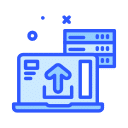Today, business growth greatly depends on how effectively you can harness information. And while the average number of applications businesses use increased from 843 in 2021 to 1,061 in 2023, most organizations still grapple with scattered, duplicated, and inconsistent data. Wonder why? Only 29% of their apps are connected.
This leaves vast amounts of business-critical data siloed and untapped.
This disconnect contributes to poor decision-making, inefficiencies, increased operational costs, and missed opportunities. In fact, the average impact of poor data quality on company revenue surged from 26% to 31% between 2022 and 2023.
Now, imagine if you could consolidate all that information into a single, reliable source – one that fuels smarter strategies and drives better outcomes. Sounds great, right?
Data matching makes that possible.
By merging disparate data records into a “golden” version, it not only enhances business intelligence but also improves operations and drives better decision-making. By enhancing data accuracy, refining customer segmentation, and automating critical processes like fraud prevention, data matching empowers businesses to operate more efficiently, comply with regulations, and strengthen their bottom line.
What is Data Matching?
Data matching – also known as record linkage and entity resolution – refers to the task of identifying and assigning two seemingly different records as one and the same across multiple data sources.
By finding more accurate matches, organizations can more easily identify duplicate records and choose to either merge them. Select a master record and discard the other identical entries. Also, identify possible matches that are in fact different entities.
For this reason, data matching is considered as the most important function after profiling, cleansing, and standardizing activities.
In this way, data matching process enables organizations to have a more complete view of each entity. Customer, students, patient, etc. – by discarding duplicate values and ensures the data residing withing their information systems is clean and accurate.
How Does Data Matching Work?
The data match process relies on several algorithms to analyze records and find matches against similar entries. However, the exact approach to match data varies depending on whether the matching is deterministic or probabilistic.
In deterministic matching, matches are identified on how exact two or more entries; on a 0 or 1 basis. here, the data match algorithm utilizes set rules and patterns to determine scores, which then are used to determine a data match.
Probabilistic matching, on the other hand, identifies matches based on a match score above a certain threshold that lies between 0 and 1.
Fuzzy logic algorithms, such as Jaro-Wrinkler, determine probabilities based on associations and weights of unique identifier data (values that don’t change overtime. Such as Social Security Number and date of birth). And to identify the extent to which a particular record matches with other records.
How is Data Matching Applied in Different Industries?
Although the outcome of data matching is to find more precise and unique records out of several similar records. The application differs from industry to industry. Here is a close look on how data matching is applied across multiple contexts:
Government and Public Sector:
Federal agencies and public institutions rely on entity resolution by examining PII data such as SSN, Passport, and licensing numbers to detect fraud, meet compliance standards. And carry out political analyses.
An example of this is The Department of Justice (DOJ) that processes several thousand FOIA requests. Each of which has to be properly interpreted, communicated with the requestor. And thoroughly researched.
Through data matching, the agency was able to identify duplicates and reduce a field from 4 million to 3 million records. Which were further minimized to 4,000 records upon filtering. The entire deduplication activity lasted just four hours which otherwise would have taken several weeks if done manually.
Identity resolution for government and public sector institutions
Read this whitepaper to understand the concept of identity resolution, its challenges, and the different identity resolution methods/solutions available.
DownloadEducation
Data matching across disparate sources such as student and teacher demographic information and others to measure student performance. Distinguish successful from unsuccessful teaching methods, analyze changes in grade. And identify policy initiatives from SLDS data.
A state ran a record linkage program with a sample and evaluated the number of students in one year who attended post-secondary education in a specific city. With the old existing program, the sample found that 22 percent of the 5,344 students in that city had gone on to higher education.
After Data Ladder’s data matching solution, that number went up to nearly 41 percent. Nearly double the first figure. For more information, read the SLDS case study.
Role of data matching in implementing and enhancing interagency SLDS
Download this whitepaper to understand the SLDS data system framework, accurate record matching, and identity resolution for P-20W data.
DownloadBanking and Finance
Banks and financial services institutions utilize data matching to identify culprits as part of anti-money laundering initiatives, meet KYC compliance requirements, or carry out FICO credit scoring.
Bell Bank carried out data matching using DataMatch Enterprise for linking data and to achieve a single, consolidated view of its customers and vendors spread across multiple services lines. From retirement to wealth management.
Through matching, Bell Bank was able to find and track each customer’s journey across the different banking services and cut operational costs. For more information, read the Bell Bank case study.
Anti-money laundering screening and data matching
Download this whitepaper to understand the AML compliance dilemma, current system limitations, and how name-matching technology is a critical challenge to AML compliance.
DownloadHealthcare
Healthcare organizations use patient matching across multiple EHR records and databases via unique identifiers such as ONC, USPS, and CAQH for a single patient view to determine the right diagnosis and correct drug prescriptions.
St. John Associates made use of data cleansing and matching to scale the deduplication of recruitment candidate records. Saving them hundreds of hours spent on cleaning and matching records. Click here for more information.
Data quality in healthcare
Read this whitepaper to understand the role of data quality in healthcare information systems – what it is, how it benefits individuals and sectors, and how to ensure data quality organization-wide.
DownloadSales and Marketing
Companies often need to find matches to remove duplicate data and erroneous contacts within CRM and relational databases. The resulting single customer view enables firms to improve upsell and cross-sell activities, enhance omni-channel marketing campaigns. And increase marketing ROI.
TurnKey Auto Events – a marketing services company for automotive dealers – were looking to reconcile sales of dealership partners with customer leads to obtain sales credit.
Using DataMatch Enterprise, they matched records from various sources to create a consolidated, single view of potential car sales. And in minimal time, remove duplicates and cleansed records in the process. For more information, read the TurnKey Auto Events case study.
Global Private Market Firm uses DataMatch Enterprise
Global Private Market Firm scales data matching across two complex systems.
Read case studyBenefits of Data Matching
Having a robust data matching tool as part of your data quality management framework can yield a wide range of benefits, such as:
1. Create “Golden” Records for Downstream Use
Data matching and cleansing software helps identify, match, and merge records stored across information systems, consolidating data and creating a single customer view. While some data fields, like name, phone number, address, etc., are the same in most applications, some systems use tracking technologies to provide deeper customer insights.
For example, data gathered through marketing automation tools like Hubspot and Marketo is generally comprehensive. Providing a complete history of how a potential customer interacted with your business over the Internet.
In contrast, if the same customer visits the company outlet in person. The amount of data gathered the representative would gather and enter on the CRM system comprise of fewer details. That too with a chance of discrepancy in information due to human error.
With data matching, businesses can have a single source of truth – data available in different databases and data sets will be tallied, consolidated. And merged to form a master data record or “golden” record, having every piece of information that you have on a particular lead, prospect, or customer.
With a complete customer view, you can better align your marketing and sales strategies. Have access to concrete insights for reporting and analyses. And ultimately make well-grounded business decisions for higher ROI and business growth.
2. Work with Clean Data that You Can Trust
Enterprises use a wide network of information systems and applications that are intricately knit to form the internal data infrastructure.
Since consumer data is collected from various communications channels. There is a high chance of discrepancy in the information entered through different mediums.
Let’s consider a prospect, James O’Quinn, who lives in North Carolina and works at Fiserv. He clicks on one of your Google ads and visits a landing page offering a white paper. He fills out the contact form with the following details:
| Name | Phone Number | Location | |
| James O’Quinn | j.oquinn@fiserv.com | +184 222 483 | North Carolina |
This information is stored in your CRM database. Upon reading the white paper. James decides to sign up for your monthly newsletter. For which he has to fill out a separate contact form on your website. In that form. He enters his personal email address rather than the business one.
| Name | Phone Number | Location | |
| James Quinn | jim.oq@gmail.com | +184 222 483 | N. Carolina |
A new record is created in your CRM showing James as a new lead as the name and email address is different this time.
A few weeks later, James visits a tradeshow and interacts with your company. He engages with your representative and takes information about the solutions you offer. He shows interest and provides your representative with his business contact details. Your representative records the following information:
| Name | Phone Number | Location | |
| Jim Quinn | j.oquinn@fiser.com | +184 222 2482 | North Carolna |
Here is a compiled snapshot of all the information that James provided during his various interactions with your business:
| Interaction | Name | Phone Number | Location | |
| White Paper Sign Up | James O’Quinn | j.oquinn@fiserv.com | +184 222 483 | North Carolina |
| Newsletter Sign Up | James Quinn | james.oq@gmail.com | +184 222 483 | N. Carolina |
| Tradeshow | Jim Quinn | j.oquinn@fiserv.com | +184 222 2482 | North Carolna |
The variations in the information are quite evident. Now, three records exist that point to the same entity, across different systems within the organization.
Having multiple records for the same person can lead to several issues. Such as sending a single email multiple times and that too with wrong name spelling. Which can significantly impact the customer experience even before it turns into a potential prospect.
This is just one example of the hundreds of scenarios in which duplicate records can affect your business.
That’s where data cleansing and deduplication come in. Data matching tools like DataMatch Enterprise leverage best-in-class fuzzy matching technology. To identify duplicate records scattered across your various data repositories.
Assigning scores to the degree of match found so you can steer clear of false positives.
The solution also allows profile your data within minutes so you know issues that exist across enterprise data.Fix them using our standardization and cleansing options, and then match them to clean duplicates.
In addition to improving customer experience, deduplication reduces the number of records in a database. Leading to lower space consumption as well as diminishes the load on the client and server whenever an application calls the data for processing.
3. Prepare Data for Business Intelligence
Before data can be used for any process or application which is also known as data preprocessing. An important step in machine learning.
It must be prepared to meet the requirements of that particular operation. To get an idea of the importance of data preparation. About $22,000 per data analyst per year is spent to prepare enterprise data for reporting and analytics purposes.
A typical analytics and machine learning project involves using data from about 6 or more sources. Due to the disparity in data formats across databases, just preparing the data – cleaning and standardizing it.
So it can be analyzed for business intelligence takes up 80% of the total time spent in the process, with only 20% of the time spent on actual analysis.
To relieve burden and ditch dependency on IT resources, data matching tools offer robust self-service data preparation capabilities. Ensuring that each data set consists of the same type of data.
Data matching tools automate the process of sieving the raw data through multiple layers, profiling, cleansing, deduplicating, and merging it for accurate insights through analytics.
With DataMatch Enterprise, you can standardize and clean hundreds of millions of records within and across data sources to normalize it. Convert notations (House no., H ouse number, H# to House no.) into what your system recognizes, change casing, remove specific characters or words, merge fields, and hundreds of other things.
It also involves converting numeric data, like telephone numbers, into the designated format. And the same pattern is followed for the rest of the fields.
After these steps are complete, you can run your data through the matching/deduplication process. Or export it to your data warehouse analytical reporting and further analysis.
Data preparation through matching ensures that your data has a proper structure. And it is ready for BI systems to pick data accurately and generate high-quality insights.
4. Increase Data Accuracy
For businesses to succeed, they need to utilize their limited resources in the most efficient way possible. However, human and capital resources are generally wasted due to poor decisions based on inaccurate records and data.
With data matching, organizations can optimize data accuracy levels across business units. Thereby improving team productivity and overall efficiency. For instance, if the sales department has accurate lead data.
The representatives will have better insights to engage prospects with a higher chance of converting them into customers.
Data matching facilitates standardization. Since records are stored in various formats, data matching tools provide the ability to define a standard.
Which can be implemented across the board. This makes sorting through data based on specific fields easier, allowing users to access complete, accurate data every time.
5. Enrich Data for Deeper Insights
Data matching allows leveraging data enrichment benefits. Which involves merging data from authoritative third-party sources with the existing internal database.
Improving the quality and consistency of consumer data can enable businesses to better streamline their marketing, sales, production, and other processes.
Scoring and profiling are generally the initial steps before any downstream data enhancement can take place.
Consumer contact details are verified, questionable data is flagged. And the address information is standardized to ensure inaccurate data doesn’t affect business intelligence.
The next step involves gathering additional insights from external resources to create a more comprehensive, data-intensive consumer profile.
Data from third-party sources may include financial data, social interests, automotive data, and life events. Which can be gathered based on the additional information available on the most reliable and preferred communication channels.
The enriched data fills any gaps in the consumer data, providing you with a complete datasheet of the ‘whats’ and ‘hows’ of your target audience. Allowing you to improve your business processes to enhance the overall customer experience.
6. Refine Customer Segmentation
For any marketing and sales campaign, customer segmentation plays a critical role, especially in big data enterprises. In fact, marketing campaigns driven by customer segmentation are known to experience an average ROI boost of 760 percent.
Demand generation marketers generally struggle with defining the boundaries derailing the personalization efforts of their marketing campaigns. The culprit? Inaccurate, incomplete data.
Offering a combination of data enrichment and verification capabilities. Data matching tools help you identify and classify your target audience based on multiple demographic factors. Such as income, marital status, age, residence, and more.
Having accurate, complete customer information helps you clearly define interests, behaviors, and other socio-economic factors for creating segments.
Allowing you to add the personalization touch in your messages. With the right kind of personalization, you can maximize the effectiveness of your sales and marketing campaigns by crafting more relevant messages for your customers.
How to build a unified, 360 customer view
Download this whitepaper to learn why it’s important to consolidate your customer data and how you can get a 360 view of your customers.
Download7. Ensure Better Compliance
With GDPR demanding companies to carefully think through their marketing strategies for European markets. Data matching can play an important role in ensuring compliance with this regulation.
Before businesses can contact a customer, GDPR requires them to ask for permission to use the email addresses and other personal information of a customer in their marketing campaigns.
Since customer interaction is omnichannel, it becomes difficult to get permission from customers. When data is inconsistent and varies across online platforms. Thus increasing the risk for incurring penalties.
But with data matching, businesses can narrow down and know exactly with which customer they are dealing with. Providing them with the ability to ask for explicit permission.
OFAC matching is another data matching use-case that we see at Data Ladder increasingly. The Office of Foreign Asset and Control (OFAC), a US Treasury Department division. That creates blacklists of individuals and countries facing economic or trade sanctions to protect federal interests.
For compliance purposes, organizations must match vendor lists, including individual transactions, against OFAC blacklists before doing business – or risk heavy penalties.
Problem is, you won’t always have exact matches. Blacklisted vendors may be using pseudonyms, data could’ve been miskeyed in your vendor database. Which means your data matching software may miss matches and breach regulations.
With our solutions, you can ensure that payments and vendors are checked against OFAC databases. Either in real-time or in batch loads.
8. Automate Fraud Prevention
Most healthcare institutions and regulatory bodies bear huge losses due to fraudulent payments and claims because of hidden relationships between entities.
The data is generally in the form of computer records that have been entered in different systems across departments or branches.
Scammers and fraudsters take advantage of multiple records stored at various points within an organization. Creating discrepancies to make it difficult to trace back to the original true record.
In some cases, employees use fraudulent tactics to forge records, like financial reports, procurement receipts, etc. for their personal benefit.
Data matching software uses world-class fuzzy matching algorithms to identify relationships among different records. Which may help in uncovering the truth behind fraud.
This technique allows companies to retrace steps, facilitating investigations to get to the source of the problem.
A majority of government bodies in the UK participate in the National Fraud Initiative. Which makes it mandatory for them to engage in computerized data matching exercise.
DataMatch Enterprise – Fastest, Most Accurate Data Matching Software

DataMatch Enterprise is a highly visual data cleansing application specifically designed to resolve customer and contact data quality issues. The platform leverages multiple proprietary and standard algorithms to identify phonetic, fuzzy, miskeyed, abbreviated, and domain-specific variations.
Build scalable configurations for deduplication & record linkage, suppression, enhancement, extraction, and standardization of business and customer data. And create a Single Source of Truth to maximize the impact of your data across the enterprise.
Download the datasheet and see how we can help your business grow!















































